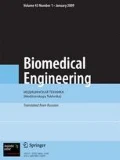Melanoma is one of the most dangerous types of cancer. The accuracy of visual diagnosis of melanoma directly depends on the experience and specialty of the physician. Current development of image processing and machine learning technologies allows systems based on artificial neural convolutional networks to be created, these being better than humans in object classification tasks, including the diagnostics of malignant skin neoplasms. Presented here is an algorithm for the early diagnostics of melanoma based on artificial deep convolutional neural networks. This algorithm can discriminate benign and malignant skin tumors with an accuracy of at least 91% by examination of dermatoscopy images.
Similar content being viewed by others
References
WHO recommendations 2005 [electronic resource], http://www.who.int/mediacentre/news/notes/2005/np07/ru/ (accessed January 17, 2018).
Gidranovich, A. V., Lud, N. G., Shlyakhtunov, E. A., Lud, L. N., Zhukovets, A. G., Prokoshin, A. V., and Kozhar, V. L., “Perspectives for the use of expert systems in the early diagnosis of skin melanoma,” Vestn. VGMU, 14, No. 2, 46-55 (2015).
Kozlov, S. V., Neretin, E. Yu., and Kukolkina, V. V., “Perspectives for the use of ‘machine vision’ in digital dermatoscopy in suspected skin melanoma,” Saratov. Nauchno-Med. Zh., 10, No. 2, 6-10 (2014).
Kozlov, S. V., Neretin, E. Yu., and Kukolkina, V. V., “Diagnosis of skin melanoma using an expert system,” Vestn. Nov. Med. Tekhnol., 8, No. 1, 1-4 (2014).
Binder, M., Schwarz, M., Winkler, A., Steiner, A., Kaider, A., Wolff, K., and Pehamberger, H., “Epiluminescence microscopy. A useful tool for the diagnosis of pigmented skin lesions for formally trained dermatologists,” Arch. Dermatol., 131, No. 3, 286-291 (1995).
The ABCDEs of Melanoma [electronic resource], https://www.melanoma.org/understand-melanoma/diagnosing-melanoma/detection-screening/abcdes-melanoma (accessed January 24, 2018).
Friedman, R. J., Rigel, D. S., and Kopf, A. W., “Early detection of malignant melanoma: The role of physician examination and self-examination of the skin,” CA Cancer J. Clin., No. 35, 130-151 (1985).
Pankratov, V. G. and Revotyuk, A. A., “Dermatoscopy of pigmented skin formations − a noninvasive test for differential diagnosis of skin melanoma,” Med. Novosti, No. 4, 6-12 (2011).
Jain, S., Jagtap, V., and Pise, N., “Computer aided melanoma skin cancer detection using image processing,” Procedia Comput. Sci., 48, 736-741 (2015).
Chernavina, V. A., “Dermatoscopy as a socially important investigation,” Zdravookhr. Yugry Opyt Innov., No. 1, 49-53 (2015).
Gavrilov, D. A., “Artificial Intelligence based skin lesions photo recognition,” AMEC LIVE and VISAGE Joint Meeting, Monaco (2017).
Tsvetkova, L. A., “Artificial intelligence technology as a factor in digitization of the economy in Russia,” Ekonomika Nauki, 3, No. 2, 126-144 (2017).
Trubitsyna, M. V., “Skin melanoma: problems and methods in clinical diagnosis,” in: Proc. XIII All-Russian Burdenko Students’ Sci. Conf. [in Russian], Molod. Innovats. Vestn., 20-22 (2017).
ISIS Archive [electronic resource], Kitware, Inc., https://isic-archive.com/ (accessed January 24, 2018).
Mishraa, N. K. and Celebi, M. E., “An overview of melanoma detection in dermoscopy images using image processing and machine learning” [electronic resource], https://arxiv.org/ftp/arxiv/papers/1601/1601.07843.pdf (2016) (accessed January 29, 2018).
Torrey, L. and Shavlik, J., “Transfer learning,” in: Handbook of Research on Machine Learning Applications and Trends: Algorithms, Methods, and Techniques, IGI Global (2009), pp. 242-264.
Shlens, J., “Train your own image classifier with Inception in TensorFlow” [electronic resource], https://research.googleblog.com/2016/03/train-your-own-image-classifier-with.html (2016) (accessed January 24, 2018).
Szegedy, C. et al., “Rethinking the Inception Architecture for computer vision” [electronic resource], http://arxiv.org/abs/1512.00567 (2015) (accessed January 25, 2018).
ImageNet Large Scale Visual Recognition Competition (ILSVRC) [electronic resource], http://www.image-net.org/challenges/LSVRC/ (accessed July 13, 2018).
Russakovsky, O., Deng, J., Su, H., Krause, J., Satheesh, S., Ma, S., Huang, Z., Karpathy, A., Khosla, A., Bernstein, M., Berg, A. C., and Fei-Fei, L., “ImageNet large scale visual recognition challenge,” Int. J. Comput. Vis., 115, No. 3, 211-252 (2015).
Sokolova, A. V. and Malishevskaya, N. P., “Errors in the diagnosis of melanocytic neoplasms of the skin,” Sovremen. Prob. Nauki Obraz., No. 2 (2018) [electronic resource], http://www.science-education.ru/ru/article/view?id=27502 (accessed September 04, 2018).
Mordovtseva, V. V., Volgin, V. N., and Kakhishvili, N. N., “Benign skin formations presenting diagnostic difficulties,” Dermatologiya, No. 1, 26-29 (2012).
Author information
Authors and Affiliations
Corresponding author
Additional information
Translated from Meditsinskaya Tekhnika, Vol. 52, No. 5, Sep.-Oct., 2018, pp. 40-44.
Rights and permissions
About this article
Cite this article
Gavrilov, D.A., Melerzanov, A.V., Shchelkunov, N.N. et al. Use of Neural Network-Based Deep Learning Techniques for the Diagnostics of Skin Diseases. Biomed Eng 52, 348–352 (2019). https://doi.org/10.1007/s10527-019-09845-9
Received:
Published:
Issue Date:
DOI: https://doi.org/10.1007/s10527-019-09845-9




